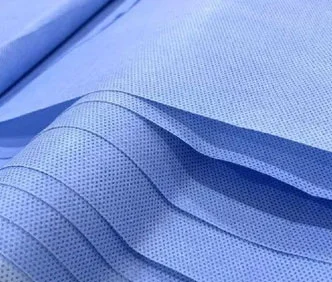In today’s world, nonwoven fabrics have become integral to many industries, including medical, hygiene, and packaging. Two popular types of nonwoven fabrics are spunbond and spunlace. Though these fabrics might sound similar, they differ significantly in their manufacturing processes, characteristics, and applications. Understanding these differences is crucial for making informed decisions, whether you're in manufacturing, product development, or purchasing.
Definition and Basic Characteristics
Spunbond fabric is a type of nonwoven material made by bonding together long fibers. This fabric is known for being lightweight, strong, and durable. It’s widely used in industries where durability and strength are essential.
Manufacturing Process of Spunbond Fabric
The manufacturing process of spunbond fabric is straightforward and efficient, making it a cost-effective option for many applications.
Raw Material Selection: Spunbond fabric typically starts with polypropylene, although other thermoplastic polymers like polyester or polyethylene can also be used.
Extrusion and Spinning: The raw material is melted and extruded through a spinneret to form continuous filaments. These filaments are then laid randomly to form a web.
Bonding Process: The web is bonded together using heat and pressure, creating a strong, uniform fabric. This process can be adjusted to create fabrics of varying weights and thicknesses.
Common Uses of Spunbond Fabric
Spunbond fabric’s unique properties make it ideal for various applications.
Medical Applications: This fabric is commonly used in surgical gowns, masks, and caps due to its strength and ability to provide a barrier against contaminants.
Industrial Uses: In construction and agriculture, spunbond fabric is used for geotextiles and crop covers.
Packaging Materials: Spunbond fabric is also used in the packaging industry for items like shopping bags and protective covers.

Definition and Basic Characteristics
Spunlace fabric, also known as hydroentangled fabric, is a nonwoven material made by entangling fibers using high-pressure water jets. This fabric is soft, flexible, and has excellent absorbency, making it a popular choice for hygiene and cleaning products.
Manufacturing Process of Spunlace Fabric
The production of spunlace fabric involves a more complex process compared to spunbond fabric.
Raw Material Selection: Spunlace fabric can be made from a variety of fibers, including natural fibers like cotton and synthetic fibers like polyester.
Carding and Web Formation: The fibers are carded to form a web, which is then laid on a conveyor belt.
Hydroentanglement Process: High-pressure water jets are directed at the web, causing the fibers to entangle and bond together without the need for adhesives or heat.
Common Uses of Spunlace Fabric
Spunlace fabric’s softness and absorbency make it ideal for various consumer products.
Personal Care Products: This fabric is widely used in baby wipes, facial wipes, and other personal care items.
Medical Applications: Spunlace fabric is also used in medical products such as wound dressings and disposable surgical drapes.
Cleaning Wipes: Its absorbency and strength make it a popular choice for industrial and household cleaning wipes.
Manufacturing Techniques
The most significant difference between spunbond and spunlace fabrics lies in their manufacturing processes. Spunbond fabric is made by extruding and bonding filaments, while spunlace fabric is created through hydroentanglement, a process that uses water jets to bond fibers.
Texture and Feel
Spunbond fabric is typically more rigid and less flexible compared to spunlace fabric, which is soft and drapable. The texture of spunlace fabric is often compared to that of natural fabrics like cotton, making it more comfortable for skin contact.
Strength and Durability
While both fabrics are strong, spunbond fabric is generally more durable and resistant to tearing, making it suitable for heavy-duty applications. Spunlace fabric, on the other hand, offers strength but with more flexibility and softness.
Absorbency
Spunlace fabric excels in absorbency due to its fiber entanglement process, making it ideal for products like wipes and medical dressings. Spunbond fabric, while absorbent to some degree, is not designed to hold large amounts of liquid.
Cost and Availability
Spunbond fabric is often less expensive to produce due to its simpler manufacturing process, making it more widely available and cost-effective for large-scale applications. Spunlace fabric, due to its more complex production, tends to be more expensive and is used in products where softness and absorbency are prioritized.
Which Fabric is Best for Medical Applications?
In medical applications, the choice between spunbond and spunlace fabrics depends on the specific use case. Spunbond fabric is often preferred for surgical gowns and masks due to its durability and protective qualities. However, spunlace fabric is favored for wound dressings and disposable drapes where softness and absorbency are crucial.
Which Fabric is Better for Hygiene Products?
For hygiene products like wipes and diapers, spunlace fabric is generally the better choice due to its superior absorbency and softness. The gentle feel of spunlace makes it more suitable for skin contact, especially in baby care products.
Industrial and Packaging Uses: Spunbond vs. Spunlace
In industrial and packaging applications, spunbond fabric is often the preferred choice due to its strength and durability. It’s commonly used in geotextiles, crop covers, and packaging materials where robustness is essential. Spunlace fabric is less common in these areas but can be used in specialized applications where a softer touch is needed.
Pros and Cons of Spunbond Fabric
Pros:
Strong and durable
Cost-effective
Wide range of applications
Cons:
Less absorbent
Rigid texture
Pros and Cons of Spunlace Fabric
Pros:
Soft and flexible
Highly absorbent
Suitable for skin contact
Cons:
Higher cost
Less durable for heavy-duty uses
Both spunbond and spunlace fabrics have unique properties that make them suitable for different applications. Spunbond fabric’s strength and durability make it ideal for industrial and medical uses, while spunlace fabric’s softness and absorbency make it perfect for hygiene and personal care products. Understanding the differences between these fabrics can help you choose the right material for your specific needs, balancing factors like cost, performance, and environmental impact.